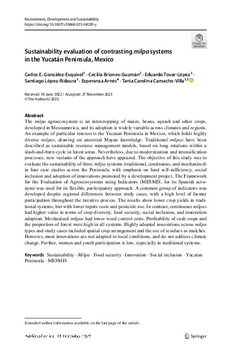Sustainability evaluation of contrasting milpa systems in the Yucatán Peninsula, Mexico
Abstract
The milpa agroecosystem is an intercropping of maize, beans, squash and other crops, developed in Mesoamerica, and its adoption is widely variable across climates and regions. An example of particular interest is the Yucatan Peninsula in Mexico, which holds highly diverse milpas, drawing on ancestral Mayan knowledge. Traditional milpas have been described as sustainable resource management models, based on long rotations within a slash-and-burn cycle in forest areas. Nevertheless, due to modernization and intensification processes, new variants of the approach have appeared. The objective of this study was to evaluate the sustainability of three milpa systems (traditional, continuous, and mechanized) in four case studies across the Peninsula, with emphasis on food self-sufficiency, social inclusion and adoption of innovations promoted by a development project. The Framework for the Evaluation of Agroecosystems using Indicators (MESMIS, for its Spanish acronym) was used for its flexible, participatory approach. A common group of indicators was developed despite regional differences between study cases, with a high level of farmer participation throughout the iterative process. The results show lower crop yields in traditional systems, but with lower inputs costs and pesticide use. In contrast, continuous milpas had higher value in terms of crop diversity, food security, social inclusion, and innovation adoption. Mechanized milpas had lower weed control costs. Profitability of cash crops and the proportion of forest were high in all systems. Highly adopted innovations across milpa types and study cases included spatial crop arrangement and the use of residues as mulches. However, most innovations are not adapted to local conditions, and do not address climate change. Further, women and youth participation is low, especially in traditional systems.

